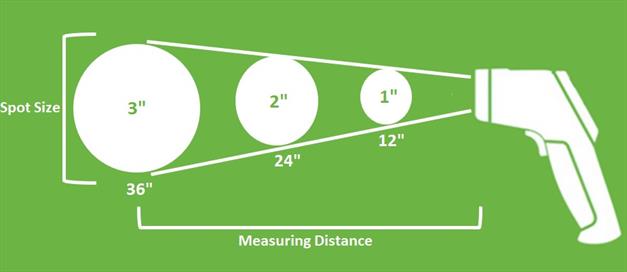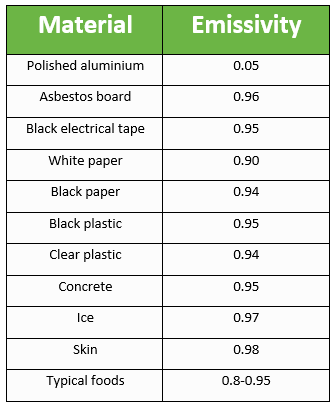IR Thermometers; How to read specifications

IR Thermometers (Infrared Thermometers are tools used to rapidly and accurately measure the surface temperature of an object and perfect for measuring temperature on mobile, hot, or hard-to-reach places. There is a wide range of IR thermometers available, each with differing specifications. To help you select the best IR thermometer for your application, we have put together a list of key terms and definitions you might find in IR thermometer specifications.
Distance to Spot Ratio
The distance to spot ratio is a relationship between the size of the area measured against the distance of the IR thermometer from the area. Depending on the ratio, the area of the surface measured will grow at a specific rate as the distance increases and smaller as the distance decreases. (See Figure 1 (below) with a 12:1 distance to spot ratio).

Figure 1 Distance to spot ratio on an Infrared Thermometer using a 12:1 ratio as an example.
Distance to spot ratio is important for two reasons:
1.Knowing this ratio will assist you in ensuring accuracy by helping avoid taking measurements from outside of the area of concern.
2.It will aid you in selecting the right IR thermometer. For example, do you need to measure a small area from a distance? A higher distance to spot ratio will be required. Alternatively, will you measure surfaces at close range? A lesser distance to spot ratio will be suited.
Emissivity
Emissivity is a measure of how well a surface emits energy as infrared radiation. Emissivity is a scale of 0 to 1, with 0 being a perfect reflector, and 1 being an object that doesn’t reflect at all, absorbing all incoming radiation.Many items fall within the emissivity range of 0.95, and as a result, will have a default emissivity setting of 0.95.
The selection of your IR thermometer will be dependant on what surfaces you intend to measure. For instance, are the surfaces shiny, or will there be significant variances in emissivity between objects measured?If so, you might need an IR thermometer with adjustable emissivity.
Figure 2 (below) outlines some everyday objects and their emissivity values.

Figure 2 Objects and their corresponding Emissivity values
Resolution
The resolution of an instrument is the smallest value shown on the thermometer display. Therefore an instrument that has a 0.01°C resolution means that it will read to the nearest 0.01°C.
Laser Pointer (dual vs. single vs. none)
Infrared is invisible to the human eye. When taking a measurement using an IR thermometer, some are designed with a laser guide, others a laser pointer. It's crucial to note that the red light you see is not taking the measurement and is not representative of the entire measurement area; it is merely a guide. IR thermometers can have no laser pointer, a single or double laser.
Although laser pointers are not taking measurements, they help ensure you measure the intended area. A single point may indicate the centre of the measurement area, and a dual-point may show the outer edges of the measurement. (Check individual specifications for more information as this may vary).
Temperature Range
The temperature range of an IR thermometer specifies a device’s range within which you can be sure of accurate measurements. Specification sheets provide temperature range values (with minimum and maximum temperatures given).If you require a device capable of measuring extremes in temperature, be sure to check that the range of the IR thermometer is appropriate.
Wavelength / Spectral Range
The electromagnetic spectrum refers to the range of frequencies (the spectrum) of electromagnetic radiation and their respective wavelengths. IR thermometers will display a spectral range of wavelengths on their specifications, and this is indicative of the measurement range of the device. Most IR thermometers have a spectral range of 8 to 14µm.
Accuracy
Accuracy is the closeness of a measurement to a specific value. Specifications will express the accuracy of a device as plus or minus a set amount.
Conclusion
Some of the terms used in infrared thermometer specifications can be technical. We have provided the key specification definitions in this article to provide a better understanding of infrared thermometers and to help you make an informed selection when it’s time to acquire one.
Need a hand finding the best IR thermometer for you? Have questions about any of the terms defined above? Contact one of the Instrument Choice Scientists. We’re here to help!
Call 1300 737 871 or email [email protected].
Also interesting
Viscometers are critical quality management tools. So, if you're involved in the production process of industries such as food, beverage, chemical, and the manufacturing of essential household goods, here's everything you need to know!

Do you work in the food and beverage industry, and you're tired of cutting up and wasting fruit to obtain a Brix measurement? Atago Instruments has solved this issue for you! The Hikari series of pocket Brix meters use infrared technology to collect Brix measurements in fruit.

